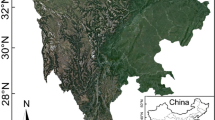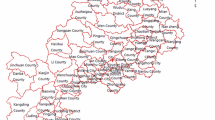Abstract
In order to monitor the high-level landslides frequently occurring in Jinsha River area of Southwest China, and protect the lives and property safety of people in mountainous areas, the data of satellite remote sensing images are combined with various factors inducing landslides and transformed into landslide influence factors, which provides data basis for the establishment of landslide detection model. Then, based on the deep belief networks (DBN) and convolutional neural network (CNN) algorithm, two landslide detection models DBN and convolutional neural-deep belief network (CDN) are established to monitor the high-level landslide in Jinsha River. The influence of the model parameters on the landslide detection results is analyzed, and the accuracy of DBN and CDN models in dealing with actual landslide problems is compared. The results show that when the number of neurons in the DBN is 100, the overall error is the minimum, and when the number of learning layers is 3, the classification error is the minimum. The detection accuracy of DBN and CDN is 97.56% and 97.63%, respectively, which indicates that both DBN and CDN models are feasible in dealing with landslides from remote sensing images. This exploration provides a reference for the study of high-level landslide disasters in Jinsha River.








Similar content being viewed by others
Change history
22 February 2022
A Correction to this paper has been published: https://doi.org/10.1007/s11227-022-04353-2
References
Prakash N, Manconi A, Loew S (2020) Mapping landslides on EO data, pp. Performance of deep learning models vs. traditional machine learning models. Remote Sens 12(3):346
Yu B, Chen F, Xu C (2020) Landslide detection based on contour-based deep learning framework in case of national scale of Nepal in 2015. Comput Geosci 135:104388
Huang Q, Wang C, Meng Y et al (2019) Landslide monitoring using change detection in multitemporal optical imagery. IEEE Geosci Remote Sens Lett 17(2):312–316
Zhong C, Liu Y, Gao P et al (2020) Landslide mapping with remote sensing, pp. challenges and opportunities. Int J Remote Sens 41(4):1555–1581
Xiao L, Zhang Y, Peng G (2018) Landslide susceptibility assessment using integrated deep learning algorithm along the China-Nepal highway. Sensors 18(12):4436
Yao Y, Jiang Z, Zhang H et al (2019) On-board ship detection in micro-nano satellite based on deep learning and COTS component. Remote Sens 11(7):762
Maxwell AE, Pourmohammadi P, Poyner JD (2020) Mapping the Topographic Features of Mining-Related Valley Fills Using Mask R-CNN Deep Learning and Digital Elevation Data. Remote Sens 12(3):547
Lu H, Ma L, Fu X et al (2020) Landslides information extraction using object-oriented image analysis paradigm based on deep learning and transfer learning. Remote Sens 12(5):752
Ji M, Liu L, Du R et al (2019) A comparative study of texture and convolutional neural network features for detecting collapsed buildings after earthquakes using pre-and post-event satellite imagery. Remote Sens 11(10):1202
Hua Y, Wang X, Li Y et al (2020) Dynamic development of landslide susceptibility based on slope unit and deep neural networks. Landslides 1:1–22
Seydi ST, Hasanlou M, Amani M (2020) A New End-to-End Multi-Dimensional CNN Framework for Land Cover/Land Use Change Detection in Multi-Source Remote Sensing Datasets. Remote Sens 12(12):2010
Liu Y, Wu L (2018) High Performance Geological Disaster Recognition Using Deep Learning. Procedia comp sci 139:529–536
Ye C, Li Y, Cui P et al (2019) Landslide Detection of Hyperspectral Remote Sensing Data Based on Deep Learning with Constrains. IEEE J Sel Top Appl Earth Obs Remote Sens 12(12):5047–5060
Liu P, Wei Y, Wang Q et al (2020) Research on Post-Earthquake Landslide Extraction Algorithm Based on Improved U-Net Model. Remote Sens 12(5):894
Wang W, Zhang C, Li F et al (2020) Extracting Soil Moisture from Fengyun-3D Medium Resolution Spectral Imager-II Imagery by Using a Deep Belief Network. J Meteorol Res 34(4):748–759
Samadi F, Akbarizadeh G, Kaabi H (2019) Change detection in SAR images using deep belief network: a new training approach based on morphological images. IET Image Proc 13(12):2255–2264
Liu T, Abd-Elrahman A, Morton J et al (2018) Comparing fully convolutional networks, random forest, support vector machine, and patch-based deep convolutional neural networks for object-based wetland mapping using images from small unmanned aircraft system. GISci remote sens 55(2):243–264
Lu P, Qin Y, Li Z et al (2019) Landslide mapping from multi-sensor data through improved change detection-based Markov random field. Remote Sens Environ 231:111235
Bianchini S, Raspini F, Ciampalini A et al (2017) Mapping landslide phenomena in landlocked developing countries by means of satellite remote sensing data, pp the case of Dilijan (Armenia) area. Geomat, Nat Hazards Risk 8(2):225–241
Chen T, Trinder JC, Niu R (2017) Object-oriented landslide mapping using ZY-3 satellite imagery, random forest and mathematical morphology, for the Three-Gorges Reservoir, China. Remote sens 9(4):333
Peng D, Zhang Y, Guan H (2019) End-to-end change detection for high resolution satellite images using improved unet++. Remote Sens 11(11):1382
Ji S, Yu D, Shen C et al (2020) Landslide detection from an open satellite imagery and digital elevation model dataset using attention boosted convolutional neural networks. Landslides 17:1337–1352
Chen Z, Zhang Y, Ouyang C et al (2018) Automated landslides detection for mountain cities using multi-temporal remote sensing imagery. Sensors 18(3):821
Chang Z, Du Z, Zhang F et al (2020) Landslide susceptibility prediction based on remote sensing images and gis, pp. Comparisons of supervised and unsupervised machine learning models. Remote Sens 12(3):502
Song D, Tan X, Wang B et al (2020) Integration of super-pixel segmentation and deep-learning methods for evaluating earthquake-damaged buildings using single-phase remote sensing imagery. Int J Remote Sens 41(3):1040–1066
Huang F, Chen L, Yin K et al (2018) Object-oriented change detection and damage assessment using high-resolution remote sensing images, Tangjiao landslide, Three Gorges Reservoir, China. Environ earth sci 77(5):183
Huang J, Xie M, Farooq A et al (2019) DInSAR technique for slow-moving landslide monitoring based on slope units. Surv rev 51(364):70–77
Zhuo L, Dai Q, Han D et al (2019) Evaluation of remotely sensed soil moisture for landslide hazard assessment. IEEE J Sel Topics Appl Earth Obs Remote Sens 12(1):162–173
Brunetti MT, Melillo M, Peruccacci S et al (2018) How far are we from the use of satellite rainfall products in landslide forecasting. Remote Sens Environ 210:65–75
DeLancey ER, Simms JF, Mahdianpari M et al (2020) Comparing deep learning and shallow learning for large-scale wetland classification in Alberta, Canada. Remote Sens 12(1):2
Luti T, Segoni S, Catani F et al (2020) Integration of remotely sensed soil sealing data in landslide susceptibility mapping. Remote Sens 12(9):1486
Lai JS, Tsai F (2019) Improving GIS-based landslide susceptibility assessments with multi-temporal remote sensing and machine learning. Sensors 19(17):3717
Moayedi H, Tien Bui D, Kok FL (2019) Slope stability monitoring using novel remote sensing based fuzzy logic. Sensors 19(21):4636
Wang HJ, Zhou Y, Wang SX et al (2020) Application of remote sensing big data for rapid respond to landslide lake disaster monitor. Int Arch Photogrammetry, Remote Sens Spatial Inf Sci 42:37–43
Holloway J, Mengersen K (2018) Statistical machine learning methods and remote sensing for sustainable development goals: a review. Remote Sens 10(9):1365
Ainiwaer M, Ding J, Kasim N (2020) Deep learning-based rapid recognition of oasis-desert ecotone plant communities using UAV low-altitude remote-sensing data. Environ Earth Sci 79:1–11
Aggarwal A, Mohammed A, Kumar A, Osama A, Sharma P, Pardasani KR (2020) Landslide data analysis using various time-series forecasting models. Comput Electr Eng 88:106858
Acknowledgements
This work was supported by Scientific Research Fund Project of Yunnan Provincial Department of Education “Earthquake relief asymmetric information game dynamics model in complicated landforms.”
Author information
Authors and Affiliations
Corresponding author
Additional information
Publisher's Note
Springer Nature remains neutral with regard to jurisdictional claims in published maps and institutional affiliations.
The original online version of this article was revised due to a retrospective Open Access cancellation.
Rights and permissions
About this article
Cite this article
Long, L., He, F. & Liu, H. The use of remote sensing satellite using deep learning in emergency monitoring of high-level landslides disaster in Jinsha River. J Supercomput 77, 8728–8744 (2021). https://doi.org/10.1007/s11227-020-03604-4
Accepted:
Published:
Issue Date:
DOI: https://doi.org/10.1007/s11227-020-03604-4




